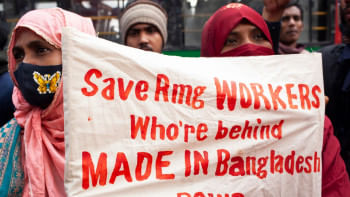The complicated issue of paying 'living wages'

A report emerging from Australia recently claimed it will take up to 75 years for many leading fashion brands to start paying a living wage to any of the workers who make their products. This is despite progress in other areas of sustainability over the past decade. The "Ethical Fashion Report" was produced ahead of the 10th anniversary of the Rana Plaza collapse. It claims progress towards paying workers a living wage has so far consisted of empty promises.
What are we to make of this? Are these criticisms unreasonable or do the authors make a decent point? Should fashion brands be under scrutiny for their failure to address this issue?
I think it is right and proper that we should use the 10th anniversary of the Rana Plaza collapse to pause and reflect on the progress made by our industry. Garment worker remuneration is clearly a part of this, and the challenges faced by workers has been in the spotlight in the run up to this anniversary.
While on one hand I would always want the best for garment workers and will continue to campaign on social issues, we all need to understand that the subject of living wages is complex. Better wages cannot be introduced by any one actor alone. A leading fashion brand attempted to do this a few years ago and found that it was impossible without widespread industry collaboration.
It is perhaps worth asking, why are people paid the wage that they are? Why does a person making clothing in Bangladesh make, say, $100 per month while one in China makes $1,000 per month? In fact, workers in China's textile industry also do not receive "living wages" as their living standards are higher than that of their counterparts in Bangladesh.
Despite all these structural challenges, I do believe it is possible to raise wages for workers, who are the most important aspect of the fashion supply chain. And we must continue to strive to do so.
For one, China's economy is more advanced and sophisticated than that of Bangladesh. Garment factories in Bangladesh are now competing with many other, higher paid industries which add more value. This has created an upward pressure on wages across the board and garment workers have been beneficiaries.
By contrast, in countries such as Bangladesh – and also India and Pakistan – the pace of economic development has been slower and industrialisation is not as advanced. It is important to stress that there are broad macroeconomic issues at play here which are deep-seated and cannot be changed by any one factory or brand alone.
Another related factor is productivity rates. Economists calculate productivity as the gross domestic product generated per hour of working time. By this yardstick, Bangladesh's productivity is less than half of China's, is slightly below Vietnam's, and just above Cambodia's. We need to improve our productivity rates to increase wages. This means raising skills and implementing more technology to create greater added value.
Similarly, we need to look at the clothing being produced, its quality, and the relation to wages. If lots of low-value items are being produced, profit margins will be small and this will impact wages. By way of contrast, in the world's most sophisticated industries, where barriers to entry are significant due to the unique nature of the product being produced, skilled labour is in sharp demand and wages are high.
Despite all these structural challenges, I do believe it is possible to raise wages for workers, who are the most important aspect of the fashion supply chain. And we must continue to strive to do so.
In the broadest sense, the biggest factor is taking into consideration the price we pay for clothing. This is a challenge for retailers as they are in a hugely competitive market. No retailer is going to reduce their prices in isolation. That would be commercial suicide.
But could we do more as an industry to educate end consumers about the lives of garment workers? Could we do more to help them understand that the price they pay for clothing ultimately has an impact on the wages paid to workers? Of course we can. Storytelling is a vital component of a modern, transparent fashion supply chain. Why not do more to tell the stories of the workers who produce our clothing?
There are a few more aspects of this issue that are worth exploring. Firstly, how does one calculate what a living wage is? I would argue that this is a nearly impossible task, with rents varying across locations, the number of dependents per person being different, and so on. To reiterate, living standards have risen in Bangladesh, with many garment workers now, for instance, having smartphones. We are not some third-world country, as occasionally portrayed by Western media.
There is also a concern that, if we ever do get anywhere near a fair wage, many brands and customers might simply decide to move production elsewhere.
A publicly listed company has to post increasingly good results, or investors will diversify their portfolio. How can a brand post both increasing margins and also pay fair prices to factories to enable fair living wages? Or is this the Holy Grail?
Mostafiz Uddin is the managing director of Denim Expert Limited. He is also the founder and CEO of Bangladesh Denim Expo and Bangladesh Apparel Exchange (BAE).

 For all latest news, follow The Daily Star's Google News channel.
For all latest news, follow The Daily Star's Google News channel. 










Comments